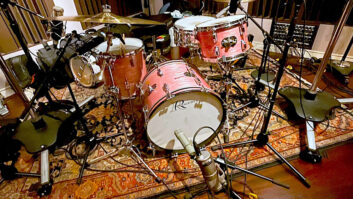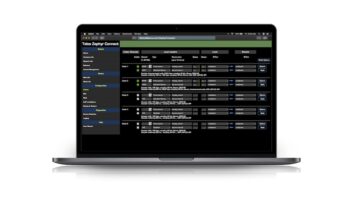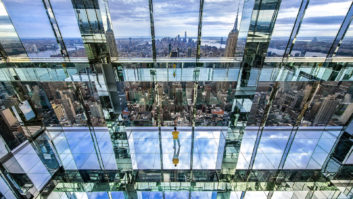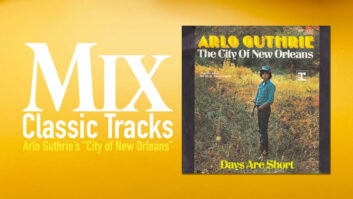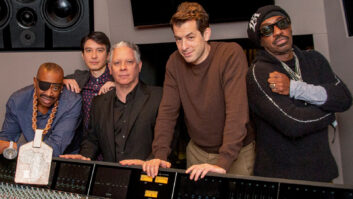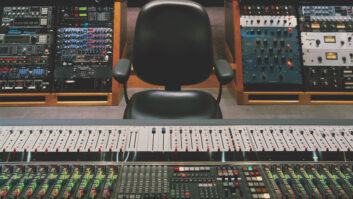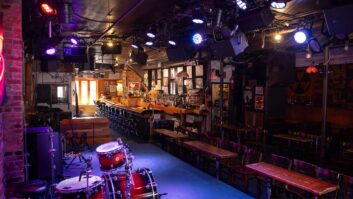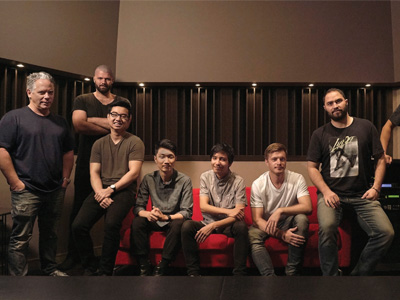
The concept for this month’s cover was clear, but in a vague sort of way. New York City itself was to be a main character, somewhat in the manner of E.B. White’s 1948 love letter to The City, Here Is New York. But for the Recording Industry. The Studio Business. In 2017. Again, clear but vague—just so it wasn’t a typical studio shot. We wanted something different.
So we called Troy Germano, whose studio business experience began at age 6 sitting in on string sessions with his father producing at Phil Ramone’s A&R Studios in the late ’60s, to an unparalleled 25-year run at the world-famous Hit Factory Studios, to an upcoming 10-year anniversary at the helm of Germano Studios. The concept began to take shape. He called his friend, Bob Gruen, an iconic rock ’n’ roll photographer, and we thought it might be cool to steal the graffitti-alley concept from a classic Ramones album cover.
The studio business, we agreed, is all about the people. It’s about the relationships formed over the years and the knowledge passed on to the next generation. We also noted that while the remaining big facilities that cater to big artists get a lion’s share of the attention, there are countless professionals, with many and varied talents, who feed these studios and make those legendary recordings possible. That’s why there’s a rock star on the cover, just a few steps away from an audio retailer, a couple engineers and producers, a manager, a label head and a songwriter or two. Everybody has a role in making the music.
We also agreed that this was just one photo from one moment on one day in one year, and it was to be a representation of a hundred talented professionals in The City equally worthy of inclusion. New York has a one-of- a-kind audio history, with a storied list of engineering and producing talent, from radio to Broadway to television and rock and roll. For the past 40 years, Germano has had a front row seat, providing the spaces where artists want to make music.
“There’s an energy in New York that no other place has,” he says. “And that energy crosses over into fashion, into film, into music and art. New York has threads through all those industries and they feed off of each other like nowhere else. When I was a teenager in the mid-’70s and my father owned part of Record Plant, then purchased The Hit Factory, there was a certain crunchiness and an element about New York, and everybody wanted to be here. I was too young to fully experience it, but it was different. There was this punk rock thing happening with the Ramones and all. Then the English influence. Rock and R&B.
“There’s an energy in New York that no other place has,” he says. “And that energy crosses over into fashion, into film, into music and art. New York has threads through all those industries and they feed off of each other like nowhere else. WhenI wasa teenager in the mid-’70s and my father owned part of Record Plant, then purchased The Hit Factory, there wasa certain crunchiness and an element about New York, and everybody wanted to be here.I was too young to fully experience it, but it was different. There was this punk rock thing happening with the Ramones and all. Then the English influence. Rock and R&B.
“Then in the 1980s, we saw the modernization of the music industry, in terms of technology,” he continues. “And I think that passion for music was carried over to new technologies, where the process of designing and building and running studios was as much fun as making the music. When my father started, there were no real blueprints. We were making it up, and we evolved with the times.
“But I think the cover of the magazine shows one thing very well: What it comes down to is relationships. Friendships. The people on that cover are from all aspects of the industry and from different age brackets. The multidimensional part of New York and the multidimensional part of what I’m still trying to do here with my two studios. It’s just a very different time. But for New York, relationships is what it’s all about. That doesn’t change.”
In those same decades, New York studios have faced a unique set of challenges, even within the larger changes impacting the recording industry at large, from production through distribution. It has been reflected in some well-publicized (though sometimes misinformed) studio closings, and in the slow exodus of many producers and engineers to Los Angeles or upstate. Not to mention the ever-rising independent studio scene in Brooklyn. It’s not easy to operate a world-class commercial studio in New York these days, with budgets what they are. For major-label work, there’s Germano Studios, Jungle City, Electric Lady and perhaps a couple more. Germano was well aware of the changes taking place in both the music market and the traditional studio model when his father and best friend, Hit Factory founder Ed Germano, died in 2003, followed by the closure of the W. 54th Street facilities in 2005 in a real estate deal that was set up for his mother.
Troy, then, set off on his own and adapted to the new music business. People made records in a lot of different ways, he figured—at home, a few days at a time, on the road, on a laptop—so only two rooms this time, not 18, but with the same attention and service.
“The best way I can describe what I wanted to build here was ‘two heavyweight rooms that are middleweight fighters.’ And that’s kind of what I did,” he says of Germano Studios. “The speed and leanness of a middleweight is better than that of a heavyweight. You have to embrace the changes and adapt. You can’t chastise people for building a production room at home or creating records inside a DAW. And it’s not necessarily about the four walls.
It’s the energy, it’s the monitoring, it’s the analog equipment, it’s how you treat the clients and it’s keeping a staff in tune. How powerful is your Pro Tools system and how deep is your plug-in list? You have to be engaged, you have to pay attention to your software and you have to be passionate to ride out the changes.”
Germano is also quick to note that because the average booking these days might be only four or five days, with the occasional long-term projects, the number of clients has to increase. That means variety, as well as a larger number of puzzle pieces.
“Today, studios have to be able to do all types of music,” he says. “Pop, rock, hip hop, Broadway cast recording, film score work, rap records, trap records, jazz records. You have to able to do anything, and that’s good. It helps develop your engineers for when they go on to be producers and engineers in their own right. In developing these young engineers, it’s important that they’re in the room with Keith Richards, with Kendrick Lamar, with Mark Ronson. Where are you going to get that experience? That education? I think you get that in a unique way in New York City.
“When my father was at the Record Plant in the ’70s, he hired engineers like Thom Panunzio and Jimmy Iovine, and they went on to become great producers and entrepreneurs,” he continues. “We’ve lost some of that over the years, so I am doing everything I can to develop young engineers. I think it’s vitally important. Those are your alumni, your future clients. It’s a long road, but it’s something I think all studios need to cultivate more. That’s why I wanted to put a couple of my engineers in the photo, to show the next generation coming up.”
It hasn’t always been an easy road for Germano and his two studios. He opened in 2008, on the downbeat of a mini-recession and at the height of a massive transformation in production budgets and consumer consumption of music. He’s made it work, and he’s had a steady stream of A-list label work in tandem with new artists and indie projects. He is genuine when he says he wants more studios to open, believing in the “rising tide” philosophy. “I fight for New York,” he says simply. “Many people talk about bringing the recording business back to New York. As far as I’m concerned, it’s never left.”
He also continues to design studios, recently spent nearly two years consulting with Universal Music Group on the reconditioning of Capitol Studios and Abbey Road Studios, and this month will be releasing a new near-field self-powered Germano Acoustics monitoring system, built in conjunction with APS, a manufacturer from Poland. He talks openly about the possibility of expanding into other cities. Just not quite yet…First and foremost, though, he will continue to fight the good fight, and he has proven that studios can survive, and even thrive. But there has to be passion, and there has to be a foundation of trust in relationships.
“If you come from a blue collar background—and that’s where my father came from—you learn at a really young age that the conversations you have with the janitor, or the delivery team that brings the equipment, or a Peter Gabriel or a Ryuchi Sakamoto, you have to give them all the same level of attention,” he explains. “My dad did that naturally. And he taught me. It’s more than just relationships, it’s about respect.”

